These posts are not for foraging. They are intended for entertainment and intellectual satisfaction only. These posts are not a field guide nor comprehensive in any way - their accuracy is not assured in any way. Do not eat wild mushrooms unless you are a professional, have substantial professional assistance or have a wealth of personal experience with a specific species. Do not make any foraging decisions based on these posts. To do so could be dangerous or life threatening.
These Posts Contains No Information Regarding Edibility Or Toxicity

As I run around NYC looking for mushrooms, I very often encounter infected trees.
In fact, I've unofficially started to consider myself the grim reaper of public trees. It sometimes feels like every other tree in NYC is infected with some kind of fungal assaillant - usually, but not always, a Ganoderma species. Already I've made several calls to 311 where trees, infested with Ganodermas at the butt of the tree, have posed a risk to pedestrians - usually with falling or weakened limbs. So far only one of those trees has been outright removed, but I have a bad feeling that more are soon to be removed.
Discovering a virulent fungus growing on a large, old hardwood tree used to be a point of excitement for me. Indeed, for some species, it still is. But after encountering tree after tree with serious fungal infections, many of which are essentially doomed, my excitement has waned, to be replaced by distress.
Perhaps no infected trees carry greater cause for sadness than the sick giants of central park. Each tree in the park has been meticulously designed, planted with an eye towards an aesthetic ideal, and often been tended to for many decades. I think I can confidently say that Central Park and the NYC park department care for their trees as or more intensively than any other public trees on Earth. Yet, despite the hard work of Central Park staff, fungus is an insidious and persistent opponent.
Before we go any further, let's get a quick crash course in Hardwood trees

Take a look at this rudimentary cross sectional diagram of a hardwood tree
You all know what a hardwood tree looks like. If you've never seen such a tree before, look no further than the photos in this post. Hardwoods grow tall and wide and, if healthy and lucky, can often live for well over a century, depending on the species. Hardwoods don't necessarily have harder wood than "softwood" trees - their primary difference is how they reproduce:
Softwood trees: Using a pine tree as an example, the tree produces pine cones. Some are female and some are male. The male ones produce pollen and the female ones hold unfertilized seeds. The male pollen is released, and is carried miles away in the wind to fertilize the female cones of other trees. Once they're fertilized, the female cones fall to the ground and the fertilized seeds are either released in the dirt or carried away by animals or other natural processes to grow another pine tree.
Hardwood trees: Hardwood trees are angiosperms, in that they produce flowers which then release pollen and themselves receive pollen from other trees that have also released pollen. Once fertilized, the tree then produces a fruit - which is basically a nutritional carrying case for a fertilized seed. The fruit drops to the ground, where it either decomposes or is eaten by animals. The seeds are dispersed by animal defecation or other natural means.
Today we will only be dealing with hardwood trees. Of course, softwood trees do get fungal infections, and there are a number of awesome softwoods in Central Park. But the majority of public, decorative trees in NYC are hardwoods, for both their hardiness and the prettiness of their yearly flowers.
That diagram above shows the internal structure of a hardwood tree if you cross sectioned it. **For our purposes, you really need to know only the following:
The heartwood: The bulk of the mass of a mature hardwood tree - the functionally dead remnants of the tree's old growth. No major life functions are carried out by the heartwood, but it provides much of the tree's structural support.
The "Butt" of the tree: The base of the tree - from where the tree meets the soil, sometimes up as high as 16 feet - obviously depending on the age, species and overall height of the tree.
The roots of the tree: These are generally, but not always, below the ground and carry water and nutrients back to the tree, through the butt, and up to the top of the tree and its limbs, all using cells in the cambium layer of the above crossection.
A tree's prognosis depends on which fungus a tree is infected with, and where on the tree the infection is.
With that base line, let's take a look at some of the ailing giants of Central Park
Grifola frondosa, Hen of the Woods infects this old oak.
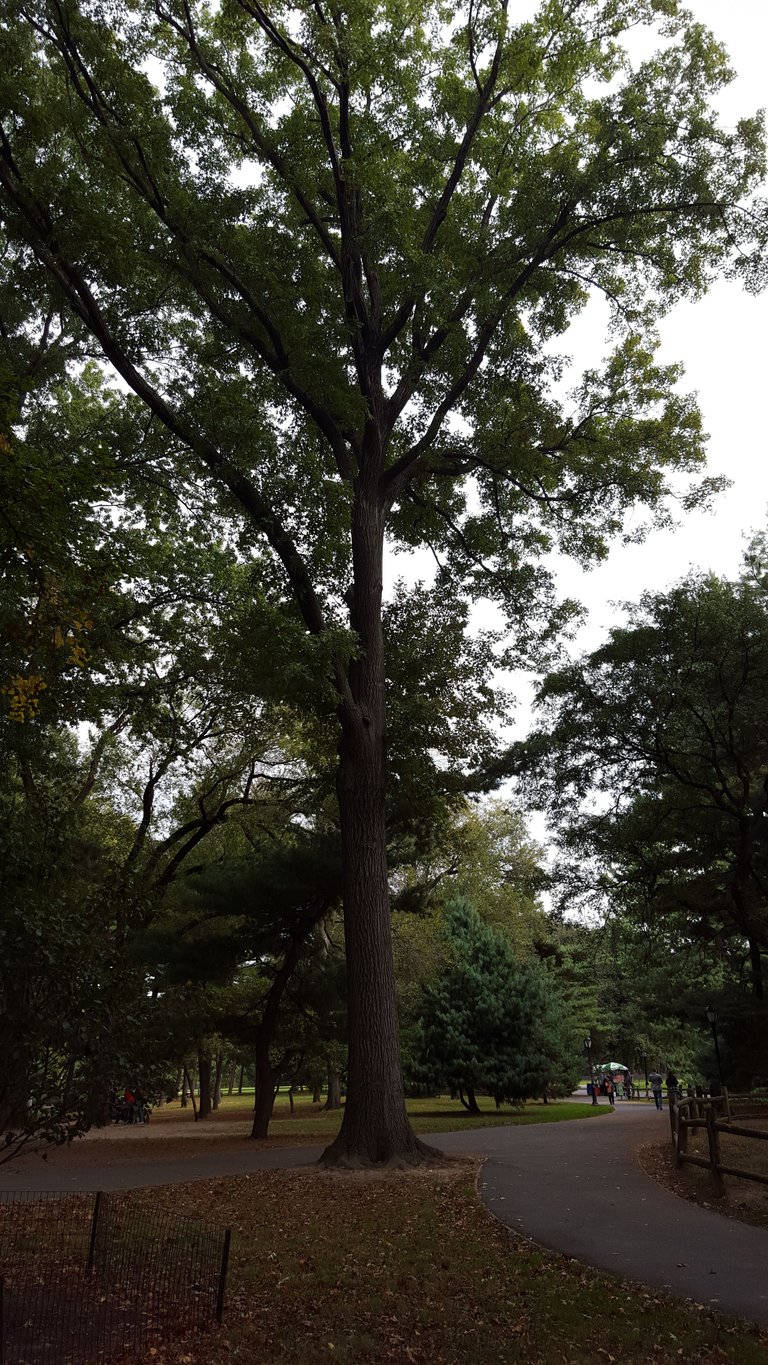
We haven't had a species post about Hen of the Woods, or Maitake yet. Spoiler alert, we will be expounding upon this particular speciment next week. However, Grifola frondosa makes a good introduction here. Almost always found on the roots or butts of Oak trees, G.frondosa causes a butt or root rot.
In the scheme of fungal infestations, butt and roots rots are generally the worst. The logic is pretty straightforward for each:
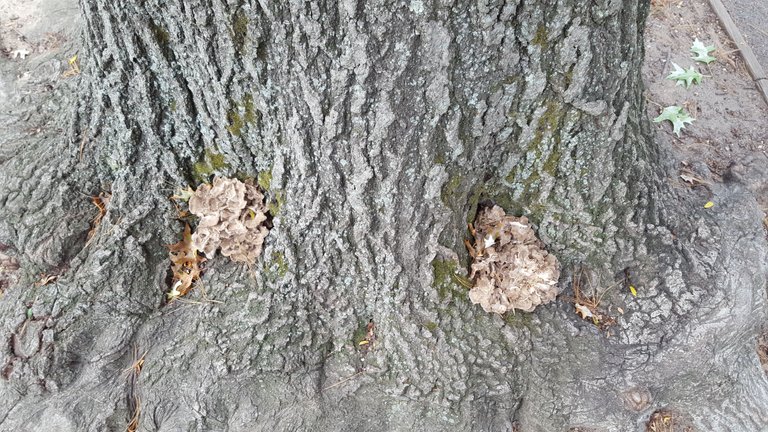
Root rot means the mushroom is devouring the tree's roots, which both inhibits the ability to take up moisture and nutrients, but also weakens the tree's anchoring on the ground.
A Butt rot begins in the butt of the tree but usually spreads upwards into the heartwood, and sometimes downwards into the roots. Either way, infestation at the butt interferes with moisture and nutrient transport, and weakens the tree's supportive heartwood at the base of the tree, which is obviously more destabilizing than weakening the heartwood higher up.
You might look at this and conclude that finding G.frondosa on an Oak bodes poorly for the tree - and you would be right. However, although the Oak is, more than likely, going to succumb to the infestation, or indirect side effects thereof, eventually, G.frondosa tends to take a fairly long time in killing a tree.
Other species are not so forgiving
We just saw this L.cincinnatus mushroom a few days ago, eating away at the butt wood of the tree

Unlike G.frondosa, L.cincinnatus growing at the base of a tree bodes fairly poorly for that tree, even in the relative short term. L.cincinnatus tends to grow faster and more aggressively, and the tree will - in the context of a tree's expected long life - fairly quickly weaken and become a danger to passerby's and structures.
Moreover, once you see the fruiting body of L.cincinnatus, you can pretty much be assured that the fungus has spread far and wide inside of the tree itself, which makes treatment difficult or impossible.

Reishii mushrooms, Ganoderma lucidum, are prized by some, but a plague to old hardwood trees
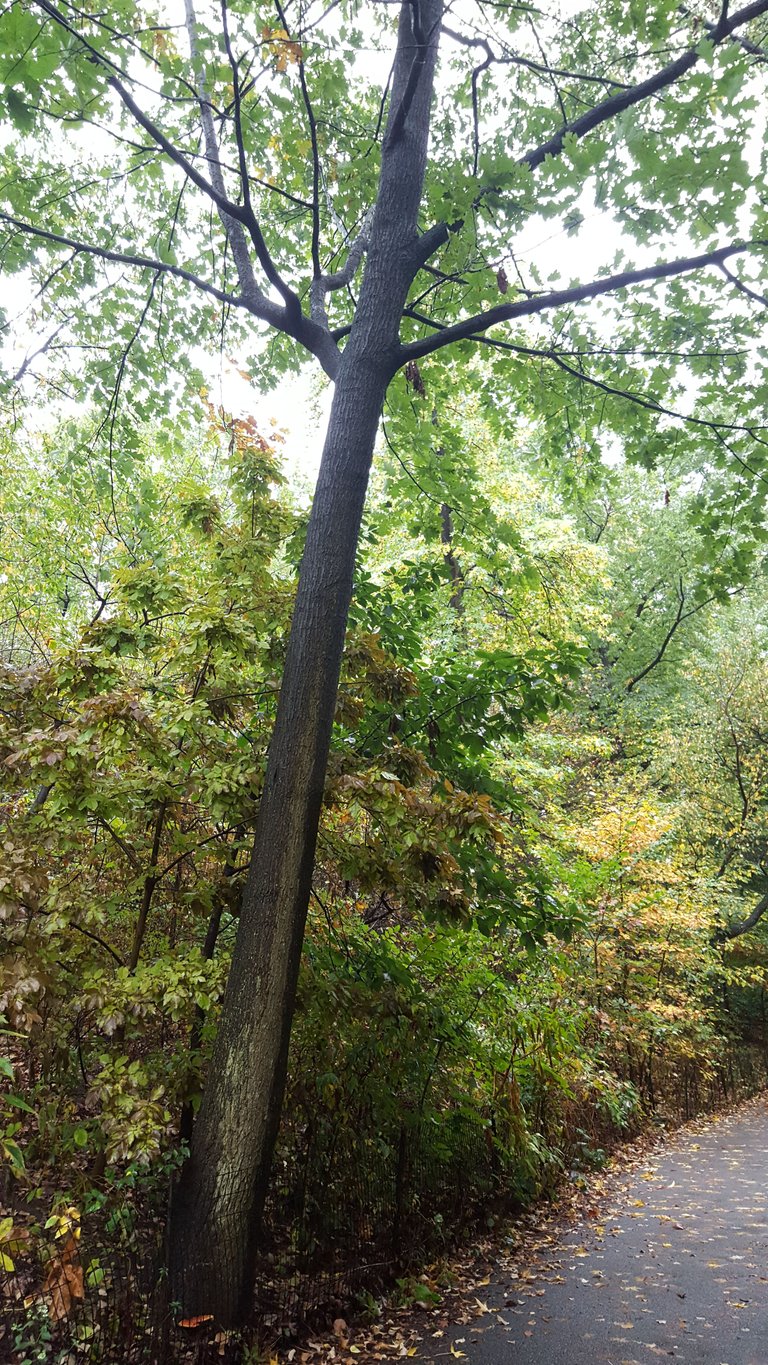
We have covered other Ganoderma species, but have not yet done a post on G.lucidum or the Reishi mushroom. Rest assured, we will. But in the meantime, I encountered this large specimen at the base of another hardwood in central park, in the beautiful Ramble, where every tree really feels like it's been there forever and was placed by a higher power of design.
Sadly, although people all over the world seek it out, this G.lucidum is also causing a butt rot in this tree. Plus, like L.cincinnatus, if you can see that mushroom body, you can be certain that the tree has already been substantially infested with G.lucidum's mycelia. Moreover, the G.lucidum has probably expanded from the butt into the roots already, which means that this tree is not only being attacked nutritionally, it is also being systematically undermined in its physical connection to the ground. It may take several more years, but this tree is probably not going to survive.
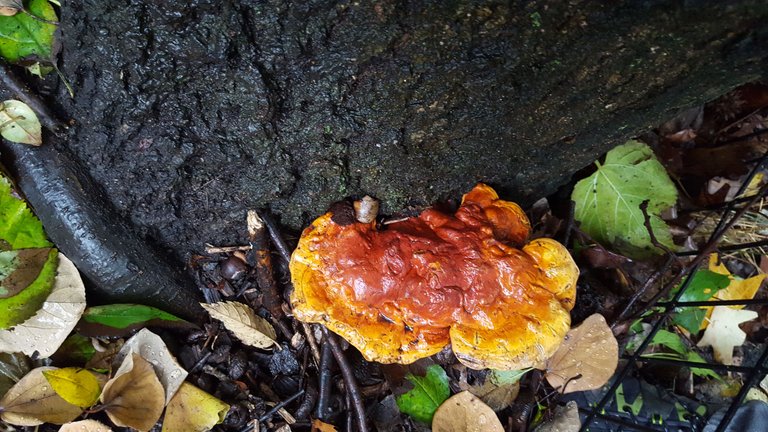
So far we've only dealt with the terrible butt rot, but what if the fungus is higher up on the tree
Not every parasitic mushroom is easily ID'd - but placement bodes better on its own.
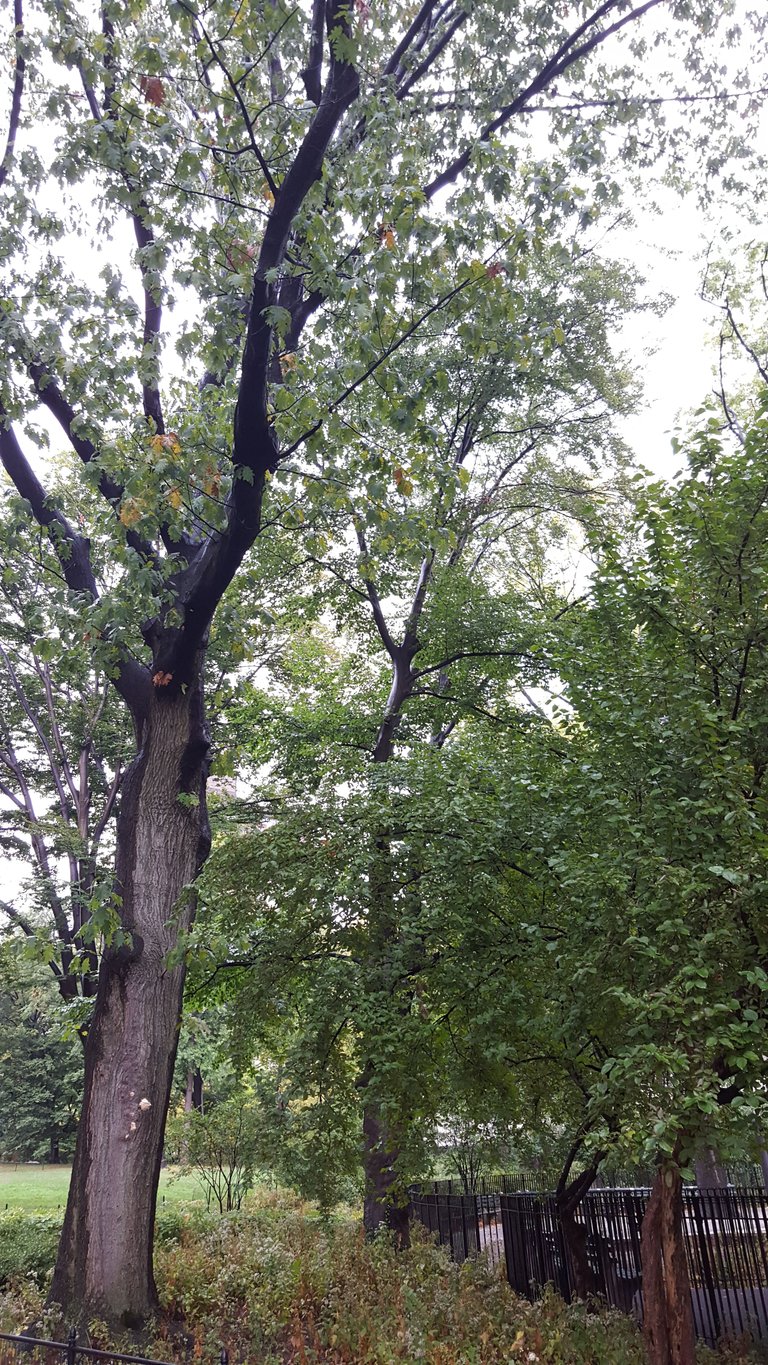
Not every fungus I encounter on a tree is immediately obvious to me, or even really worth taking the time to identify. You can see on this tree a kind of undifferentiated mass of fungal body. This could be a Ganoderma species that hasn't really formed into a cap, or a different genus all together. I really have no idea and couldn't get closer to the mushroom bodies to get better photos or samples.
However, the mere fact that the mushroom is growing higher up on the tree almost definitionally bodes better for the tree as a whole. It is certainly possible that the infection of this fungus has been fairly substantial, and maybe even goes down into the butt and roots. But, in general, heartwood rot higher up on the tree is less detrimental, and much slower in its damage, than butt or root rot is. Which isn't to say that this tree is necessarily healthy.
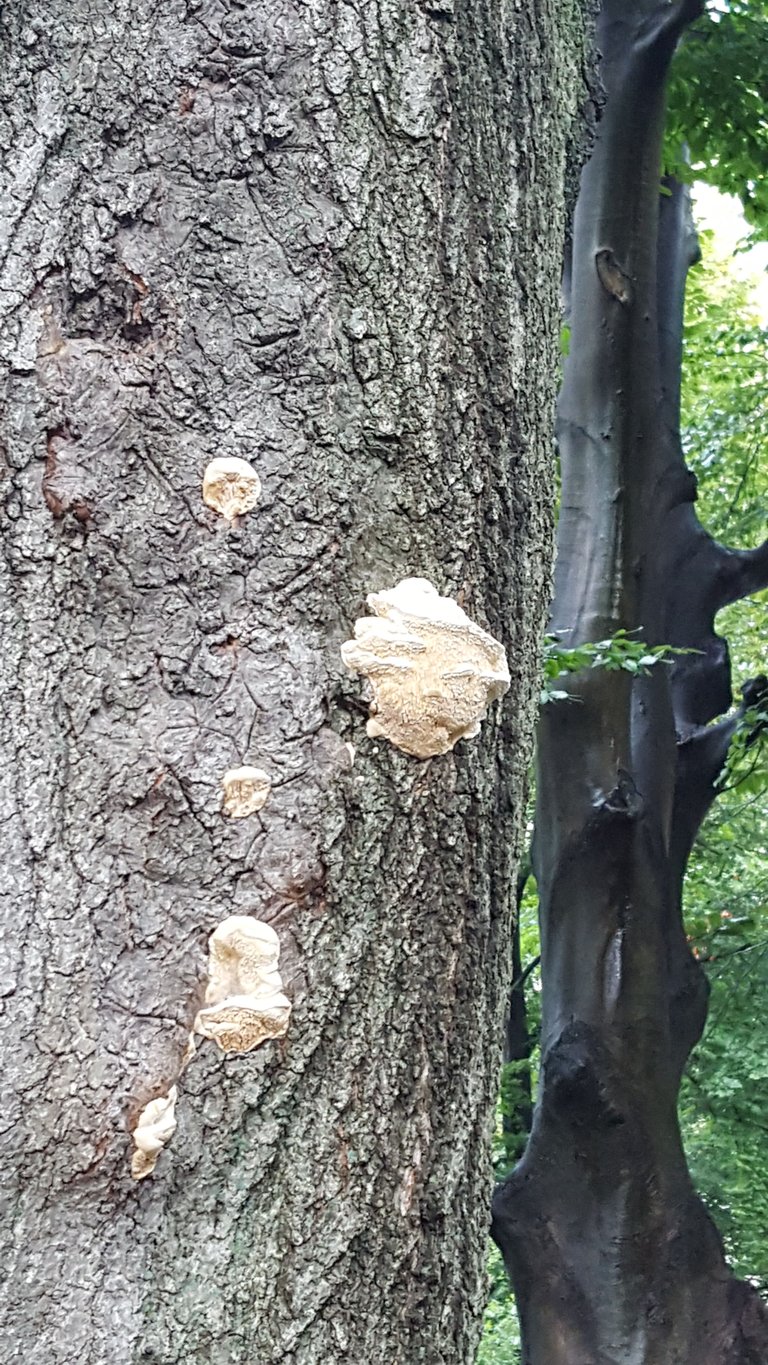
Some of the trees in central park are truly gargantuan, and probably well over a century old. This makes it all the more tragic when fungus tightens the noose.
Here we have a truly majestic hardwood that, as you can see, has a severely advanced fungal infection.
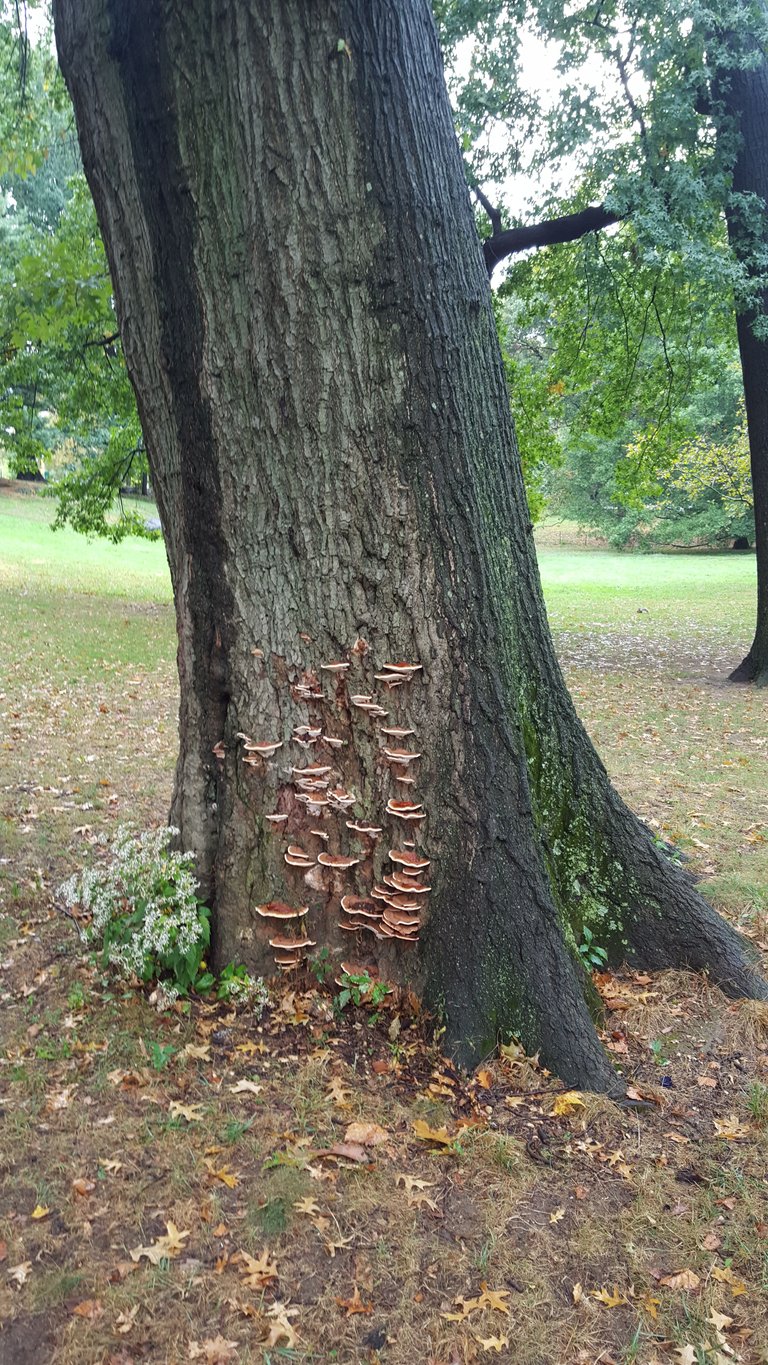
I could not get closer to this tree because of a fence that closed off that lawn, but even from this distance I feel comfortable saying that these are probably Ganoderma's and, given its prevalence elsewhere in the city and in the park, probably G.applanatum.
The specifics hardly matter in this case however. It does not take a tree specialist to realize that this tree is dying. Although the infestation has clearly spread far beyond ability of the tree, or a tree care specialist to fight, the tree continues to live without any obvious signs of nutritional deficiency. In large part this is probably due to its simply immense size.
I got all around the giant base of the tree, from a distance, and only found this one side growing mushroom caps. Large swaths of this old giant's butt remain functional - and the same can probably be said of much of its immense heartwood core and root network.
But, with this degree of fungal infection, right at the base of the tree, I can't imagine how, inevitably, this tree will not succumb. It may take many more years, but this infection already seems to have runaway, and it not likely to get better with time.
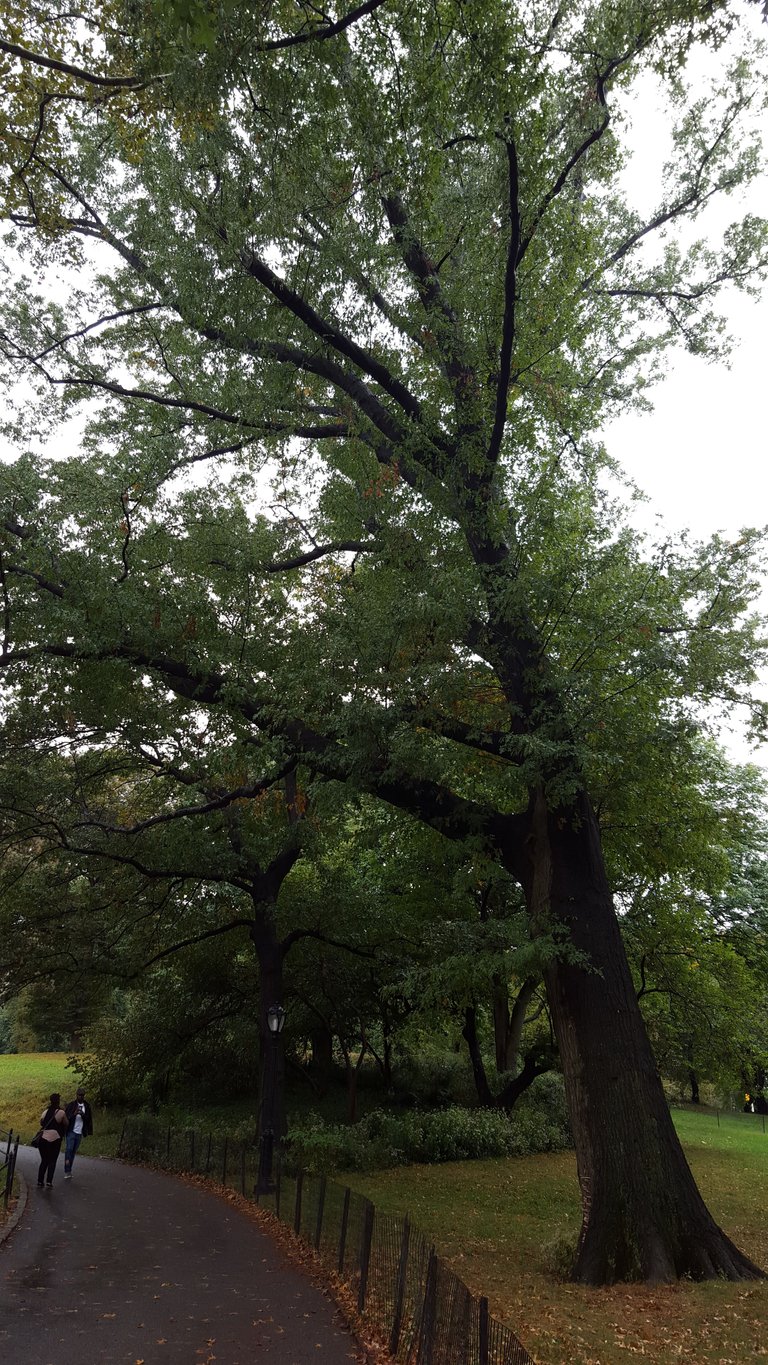
Although I understand why a tree this awesome would be allowed to live with a major fungal infection, I'm not sure I agree with the decision. In effect, this tree is becoming a hot bed for billions, possibly trillions given the number of caps, of mushroom spores to be spread all around the park.
And this is the result.
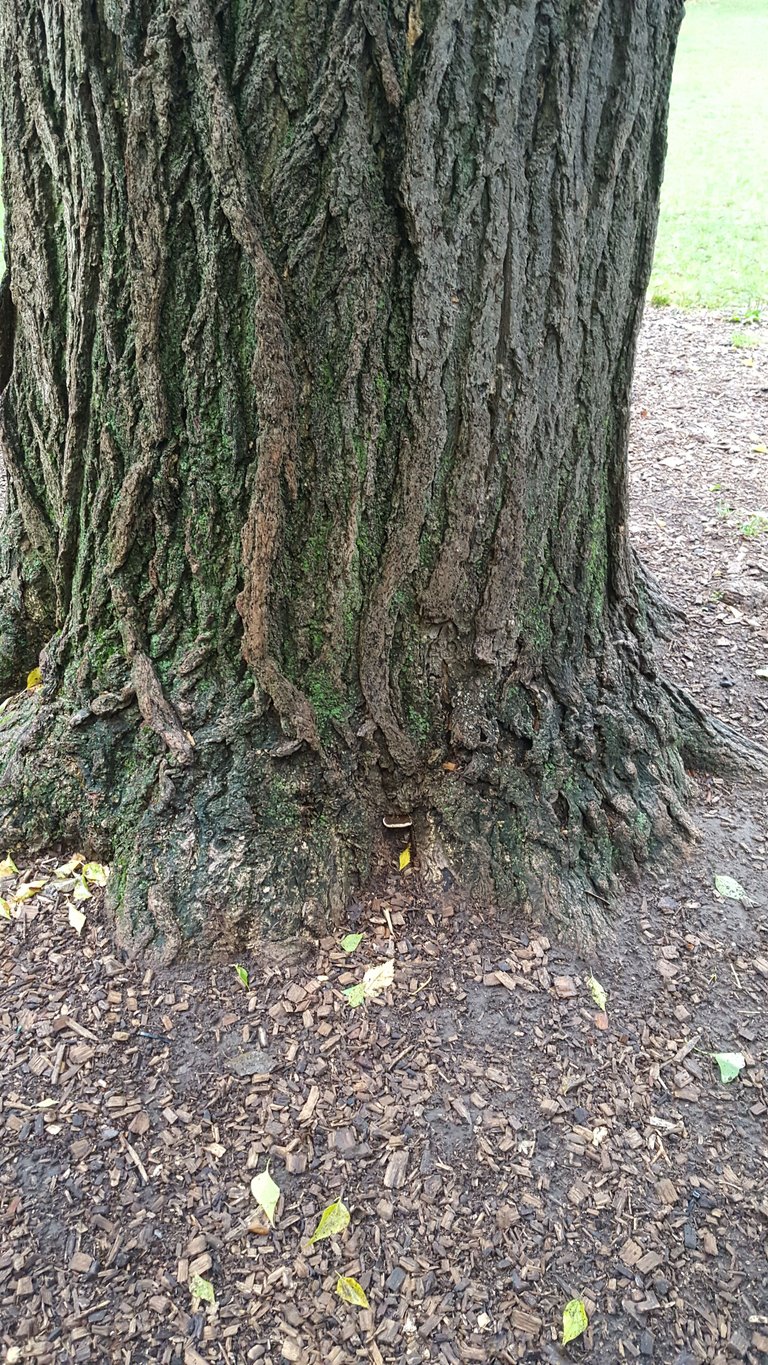
Here we have another old hardwood. At a distant or a glance, it looks unmolested. However, if you take a closer look, you can see the tiny G.applanatum cap springing from the butt. It isn't that big, nor does it appear that imposing, it is nonetheless a potential death sentence. The presence of the cap indicates a significant infection which, as time passes, will make the tree more susceptible to being toppled by the wind, losing limbs, or becoming malnourished.
And every time one of these infections starts, the mushroom cap forms and billions more spores are released into the air. They travel around the city, looking for damaged entry points into the trees, usually around the roots or butts. Of course tree damage is super common in a city this size, and so the spores have lots of victims to chose from.
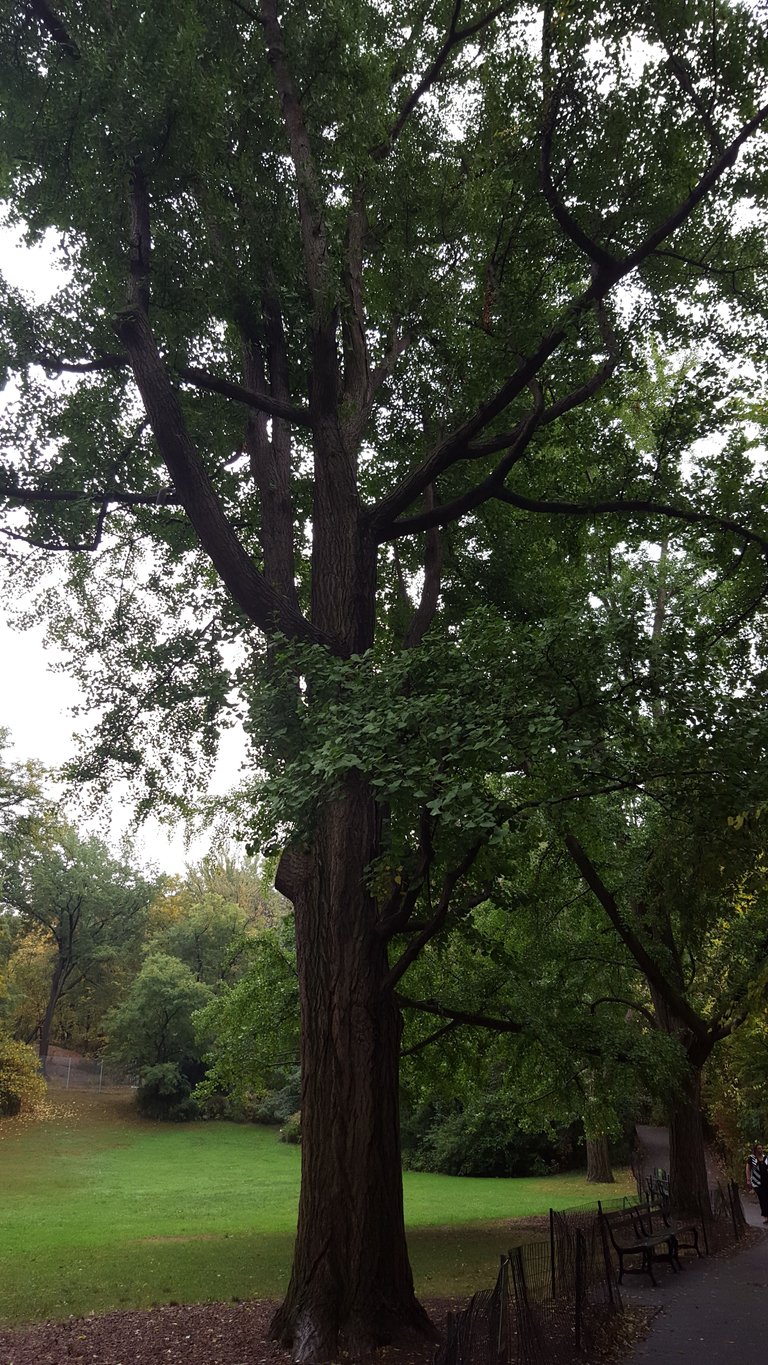
The result is a citywide epidemic of fungal infections without end in sight. On the one hand this will keep me busy. But on the other, it's a municipal tragedy in slow motion.
THIS POST IS NOT INTENDED FOR FORAGING PURPOSES AND TO USE IT FOR THOSE PURPOSES WOULD BE DANGEROUS. DO NOT HUNT WILD MUSHROOMS WITHOUT RELYING ON A COMBINATION OF PROFESSIONAL FIELD GUIDES, IN PERSON PROFESSIONAL GUIDANCE, OR IN PERSON GUIDANCE BY SOMEONE TRUSTWORTHY WHO HAS COPIOUS LOCAL, SPECIALIZED MUSHROOM HUNTING EXPERIENCE. FAILURE TO DO SO CAN RESULT IN GRIEVOUS PERSONAL HARM OR DEATH.
Photos Are My Own
Information Sources:
[1]Me On Ganoderma Applanatum with references
[2]Michael Kuo on Ganoderma lucidum
[3]Michael Kuo on Grifola frondosa
[4]Me on Laetiporus cincinnatus with references
[5]Iowa State University - Heartwood Rot of Trees
[6]North Carolina State University College of Agriculture and Life Sciences
[7]Great breakdown about how trees work from "International Timber"
[8]Sciencing on Pine Tree Reproduction
[9]Important of a Tree Butt From Thoughtco.
[10]Arborilogical.com on Ganoderma lucidum and tree health
It would not be a far stretch of the imagination to theorize that a mycology enthusiast (perhaps with a slant towards the culinary) is inoculating hardwoods at the park only to reap the delectable rewards later.
That is the greatest conspiracy theory I've ever heard.
This is a really awesome post! I forage and grow mushrooms myself, and run the website http://www.medicinalmushies.com. Great work! Following you!
Thank you! I'll check ot your site.
At least with some butt rots (like the Dyer's Polypore, Phaeolus schweinitzii) in the coniferous forests of the US West), the fungi is ubiquitous. Most trees in a stand have it. It's only when the tree is compromised, like from damage to exposed roots from fire (or in a park, by being hit with a mower), or just gets old, that the fungus finally has an impact. It's part of the natural ecological process of forests. For parks, it means constantly planting new trees - or maybe not mowing the grass so short around some of these older trees. It would be nice if parks could leave the old trees with their fungi, because they provide habitat and food for whole other parts of the ecosystem.
@fabulousfungi brought up some similar points elsewhere in the comments - and that is the dilemma of even a park like Central Park - they are leaving many trees up with fungi intact - all of the ones in these photos for instance - but because its only a "sort of" ecosystem, i wonder whether that's the right move or not.
Unfortunately for the many street trees around the city, they live in relative isolation and with a lot of physical abuse. I suppose the fact that any of them live several decades is a miracle in the first place.
Thanks! I live in a coniferous rain forest and I was just feeling guilty by the fact that I love peering at the various fungi and lichen. It's possible that many of the trees that fall on our property were infected but when they fall we use them for the next year's firewood. This year we didn't need to cut any trees down, the fallen trees were enough. Whoohoo! We are the ecosystem! ;-)
Nice post. You sure love mushrooms ^_^
You have a really bad opinion of some mushrooms.
In the wild, parasitic fungi help remove old trees, clearing the canopy for younger ones to get access to sunlight, and creating a more diverse environment.
Monoculture plantations and the lack of forest regeneration create unhealthy environments. Maybe we should create parks with more diversity instead.
Or just plant maples, pretty much nothing grows on living maples (except for Oxyporus populinus, that think loves maple trees).
I have no hard feelings towards any mushrooms - and that includes those awful orange tentacles that grow in Japan and kill people after a small bite.
Having said that, I'm not particularly happy to see these old trees die out, even if it is a fungus carrying out its natural processes in a designed environment well suited to it.
Central park is pretty diverse, as parks go. But it ain't no forest, and the loss of these old trees is momentous. Maybe a more resilient design will take their place, but I certainly would never see a new tree reach such heights in my lifetime.
I get your point, those trees are landmarks.
Just playing devil's advocate here.
And your points are not wrong. Though I can't speak to Maple's fungal resilience.
I tell you, nothing grows in maple-only forests. You won't find much on the living trees, neither around their roots.
My theory is maple trees release some antifungal substances, but only when they're alive. Tons of stuff grows on maple logs.
Mmmm! I see another reason to love maple syrup... It's antifungal!
Mmmm! I see another reason to love maple syrup... It's antifungal!
That was really educational. Thank you for the very well-made post expounding the plight of these old hardwoods. Would the environment and spacing that these trees are growing in (in the midst of NYC pollution/ growing sparsely) make them more susceptible to these issues, or is it simply a matter of time and a common way that all hardwoods meet their demise?
My intuition tells me that it would be much less of an issue in an area dense with biodiversity without so many environmental stressors, but I'm curious.
That's a great question, and I really don't know the answer. Certainly the exposure to foot traffic and human vandalism is a major factor in opening weaknesses for fungus to invade.
Common sense would seem to dictate that pollution and/or the artificial environments for street trees probably aren't a net positive - but that would just be a guess.
As to whether the lack of biodiversity hurts things, again I can't say anything concrete, but perhaps it makes it more likely for spores to land on target rather than on nearby, more inhospitable life. Again though, that's pure guesswork.
Whatever is urging it on, there's no doubt the problem is real. And of course the information is applicable for hardwoods everywhere - its just particularly visible in the city
Well I am now considerably more informed then I was before, some lovely pictures in this and also some amazing looking fungi. Following for more mushroom goodness.
Thanks for reading!
Great post!
used to love mushrooms (the kitchen ones not the fun ones) then ones got intoxicated aaand since then got scared from ever collecting them alone, be carful guyes
Definitely correct to be careful if you choose to forage wild mushrooms. Not sure what happened to you though - did you accidentally eat a poisonous mushroom?
Congratulations @dber! You have completed some achievement on Steemit and have been rewarded with new badge(s) :
Click on any badge to view your own Board of Honor on SteemitBoard.
For more information about SteemitBoard, click here
If you no longer want to receive notifications, reply to this comment with the word
STOP